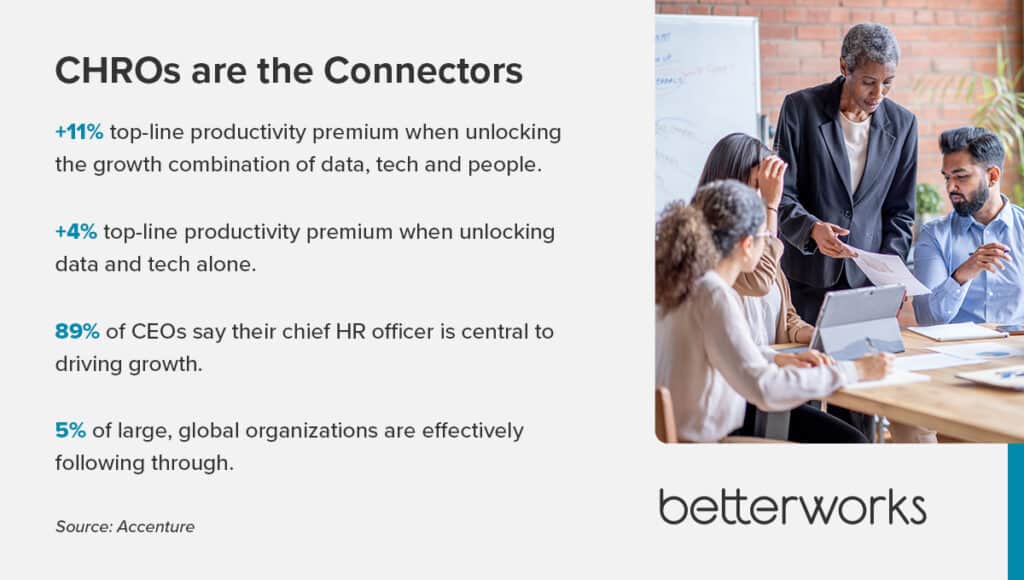Editor’s note: This is the third in a series of six articles on how to become a more strategic HR leader.
Transforming how we manage people and performance is at the heart of business success. Yet many in HR struggle to articulate how innovation in HR drives positive business outcomes. We get stuck talking about the problems of the process. It’s hard to manage, very manual, and highly administrative, it’s not a system that meets HR’s needs — and we leave it there.
The boardroom doesn’t respond well to this reasoning and HR is unsuccessful at securing investment.
The good news is that executives are ready to hear a more compelling, business-oriented case. Research from Accenture found that unlocking the growth potential of data, tech, and people produced an 11% increase in top-line productivity, compared to a 4% increase when people were excluded. Business leaders clearly recognize this opportunity, as 89% of CEOs agree that their chief HR officer plays a pivotal role in driving long-term profitable growth, yet only 5% of global organizations are following through.
But even if leaders are ready to hear your business case for HR change, making the argument can be challenging. Let’s talk about securing the investment and buy-in you need.

Articulate the benefits of the future state
The most direct way to make your case for HR transformation is to start with a one-page executive summary linking the business imperatives to what you’re trying to achieve in HR. Outline what’s broken within your existing performance process, why it doesn’t work (not just that people don’t like it) and what the ideal future state looks like. Identify the benefits of reimagining performance management for each stakeholder persona in the organization: employees, managers, HR leaders, and company leadership.
Your peers in leadership — the CEO, CIO, and COO, among others — are pivotal in helping flesh out the impact of transformation on each stakeholder group. Talk to them to better understand the nature of their concerns. Are they specific to your performance management solution, or are they related problems that may stem from faulty performance management processes? For example, employee disengagement or productivity declines could be tied to a lack of clarity about what goals to prioritize, or distrust in how their performance is measured. In these examples, taking a different approach to performance management could improve the major indicators.
Whether the issues are tied to performance management or another workforce challenge, understanding what keeps your internal constituents up at night, and the likely sources of those issues, will help you think about what changes can improve organizational outcomes.
When you articulate how your program will answer business challenges to fellow business leaders, you can earn their support before officially making your case for change. By then, you’re presenting to a group of proponents rather than skeptics.
Whether the issues are tied to performance management or another workforce challenge, understanding what keeps your internal constituents up at night, and the likely sources of those issues, will help you think about what changes can improve organizational outcomes.
As you outline your vision, have a basic plan for the technology you’ll need to reach the desired state. Talk with your peers in IT about how to best integrate available software options with your existing tech stack. You don’t need to come to the table with a request for a specific product, but you should be able to demonstrate that you’ve researched your options and have solutions in mind.
Build your case with the most meaningful metrics
No matter how idyllic a picture you paint, you won’t get traction without data. But you can’t include every single metric in a one-page summary without overwhelming your audience and diluting your impact.
You need curated, targeted data points to illustrate how you’ll achieve this future state. Ask yourself, “What am I trying to solve for?”
Consider the return on investment (ROI) when choosing the metrics you want to highlight. Quantitative metrics are usually better, as qualitative metrics can be perceived as “fuzzy.” Look for data points that are accessible, in-depth, and will resonate with your audience — you want to deliver a report that’s substantial and compelling.
Next, choose the HR metrics that matter most to your specific organization. Look to the business strategy for cues. For example, if there’s a big drive in the organization to reduce costs, then you might show ROI based on efficiency, cost savings, and time savings. If the organization has a big appetite for mergers and acquisitions, then you might include metrics related to employee alignment around the combined company’s mission, vision, and goals.
Overcoming ‘good enough’
Oftentimes, the biggest obstacle is inertia, a sense among leadership that what your organization has is sufficient. Sometimes the high costs of a recent implementation, such as an HRIS system, prevent an objective evaluation of whether all elements of that solution are working as they should. If you’re in this situation, it’s wise to provide data to show the cost of staying with the status quo.
Not only may there be limitations to your company’s current state, but the cost of making things better by leapfrogging to a more advanced technology can justify or even outweigh the cost of implementing it.
Be ready to handle objections
Although your one-page summary won’t include every data point, be ready to provide additional details to address inevitable objections. For example, you’ll likely be questioned about the cost of implementing a new performance management process. You’ll want to be ready to give estimates — just don’t forget to lay out the cost of maintaining the status quo, as mentioned above.
For example, to prepare for questions about changing solutions providers, look at when your current provider’s contract expires and how much it would cost to recast that solution to support the desired future state. By doing this, you refocus the discussion on the cost of doing nothing in terms of lost productivity, misalignment, or added cost — whichever metric your audience values most.
Find the right moment to state your case
Once you’ve developed the most effective case for change, plan for the right moment to bring it to leadership’s attention. How will you know when that is? Here are a couple of examples.
To successfully sell your vision for HR transformation, you need three ingredients: an articulation of how your recommendations will drive business outcomes, data that demonstrates the value, and the right moment to present.
Businesses go through natural rhythms, and HR leaders can time those cycles to make the case for HR transformation. There’s typically an internal funding cycle, where upcoming initiatives are submitted for review and approval. In a large enterprise, this usually happens during the last quarter of the fiscal year.
At this point, the leadership team is primed to hear recommendations for driving business value in the upcoming year.
Alternatively, you could state your case alongside another transformation project or major business change. Maybe you’re undergoing a digital transformation or have an ambitious new CEO who’s looking to make major changes. In either case, the business is already in flux and is more open to hearing about workforce transformation.
To successfully sell your vision for HR transformation, you need three ingredients: an articulation of how your recommendations will drive business outcomes, data that demonstrates the value, and the right moment to present. Follow those steps, and you’re primed to make a compelling case for people innovation.
As VP of HR Transformation at Betterworks, Jamie helps customers reimagine the way employee performance is managed with proven systems and processes that work. She is co-author of the book, Make Work Better, and draws inspiration from her more than twenty-five years of HR leadership experience, spearheading organizational development, HR transformation, and employee engagement strategies that boost business performance.
Be the strategic HR leader everyone looks to


